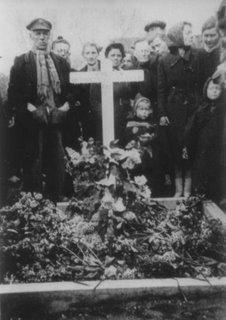What happened at Molenaarsgraaf, Netherlands during WW2

This photograph shows the service held for the six British Airmen buried at Molenaarsgraaf, Netherlands on the Dutch Liberation Day on 4 May 1945. It is one of a series of photographs taken during the service and sent to Mrs Selina Blair, widow of one of the airmen a couple of years after the war together with an eye witness account of the events at Molenaarsgraaf in May 1944 and May 1945.
On the night of 21 / 22 May 1944, a Lancaster ND559 was shot down over the village while returning from a bombing mission to Duisburg. Six British airmen lost their lives and were buried in the village churchyard. These airmen were Squadron Leader Jack Blair, Sergeant J.T.E. McCaffery, Flight Sergeant E.E.E. Roberts and Flight Sergeant R.G. Watts. The pilot, Flight Sergeant William Ward survived the crash and spent the rest of the war as a POW.
The German Nightfighter pilot who shot down the Lancaster ND 559 that crashed at Molenaarsgraaf was Hauptman Martin Drewes and the Burgomaster of Molenaarsgraaf at the time of the plane crash was Mr D. Brouwer. After the bodies of the dead airmen had been identified and inspected by the German authorities on 22 May 1944 the German Town Major from Dordrecht said that they should be buried by the villagers, but no coffins should be used and no crosses or flowers were to be placed on the graves.
However, the Burgomaster asked the men of the villagers to make six wooden coffins and a wooden cross. Working through the night the coffins and cross were made and the airmen were laid to rest with due respect, and flowers were placed on the grave. The Burgomaster and other villagers later wrote to the bereaved families of the six airmen and explained what had happened to their loved ones. I have been allowed to read through the letters sent to Mrs Selina Blair, who passed away in December 2005 more than 60 years after thr war. What follows is a brief summary I have made from this correspondence.
On the day the Dutch were liberated from the Germans in May 1945, the Burgomaster led the villagers to the Churchyard, together with some Allied soldiers who had been hidden for several weeks following the Arnhem Operation. Virtually all the villagers attended the funeral service. Large bouquets of flowers were placed on the grave. At last, after almost a year, due respect could be given to these airmen.
Each year since the end of the Second World War, on 4 May, Dutch Liberation Day, the six airmen who lie at rest at Molenaarsgraaf are remembered and honoured for their sacrifice. Their crewmate, Flight Sergeant William Ward, visited the village and the graves of his crewmates after the war. He came from the Walsall area. After it was discovered he had survived and become a POW, Flight Sergeant Ward’s mother wrote to the families of some of his crewmates to give them the little information she knew via correspondence received via the Red Cross. This was a magnificent gesture, much appreciated by the other families.
The events that took place at Molenaarsgraaf, Netherlands are worthy of remembrance. The six airmen laid to rest in the village will long be remembered, as should the efforts of the villagers to give these men a fitting and respectful funeral.
J. Ritson
July 2006




